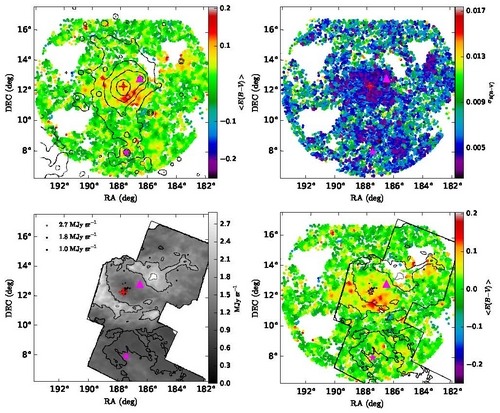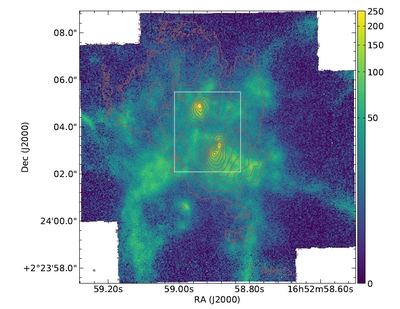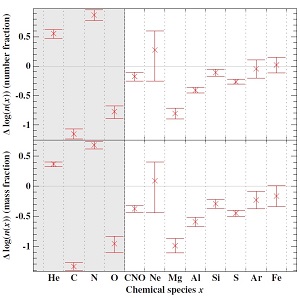The GALEX Ultraviolet Virgo Cluster Survey (GUViCS) (Longobardi et al.)
- Details
- Published on 15 January 2020
Vol. 633
1. Letters
The GALEX Ultraviolet Virgo Cluster Survey (GUViCS) VIII. Diffuse dust in the Virgo intra-cluster space
 Dust is thought to be destroyed by sputtering in galaxy clusters, which are rich in X-ray emitting hot gas. However, some dust may still exist in shielded regions or from gas tails that have just been stripped from galaxies. Measurements of the amount of dust in clusters have derived extinctions between AV=0.004 and 0.5. The present work represents the first detection of diffuse dust in the intra-cluster medium of the Virgo cluster out to ~0.4 virial radius. The authors have used the near-ultraviolet-I colors of about 12000 background galaxies with redshifts 0.02 < z < 0.8, and find an average reddening E(B - V) ~ 0.042 mag within 1.5 degrees or 0.3 virial radius from the cluster’s center. Assuming a Large Magellanic Cloud extinction law, they derived an average visual extinction AV = 0.14, leading to a total dust mass of Md = 2.5 10^9Mo and hence a dust-to-gas mass ratio of Md/Mg = 3.0 x 10^-4, which is much lower than in the Milky Way. The far-infrared emission of the dust was not detected by Herschel at 250 micron; this means that either the dust temperature should be low, about 10 K, or that the dust has lower emissivity than usual. Nevertheless, this diffuse dust in the Virgo cluster must originate from the galaxies through tidal or ram-pressure stripping.
Dust is thought to be destroyed by sputtering in galaxy clusters, which are rich in X-ray emitting hot gas. However, some dust may still exist in shielded regions or from gas tails that have just been stripped from galaxies. Measurements of the amount of dust in clusters have derived extinctions between AV=0.004 and 0.5. The present work represents the first detection of diffuse dust in the intra-cluster medium of the Virgo cluster out to ~0.4 virial radius. The authors have used the near-ultraviolet-I colors of about 12000 background galaxies with redshifts 0.02 < z < 0.8, and find an average reddening E(B - V) ~ 0.042 mag within 1.5 degrees or 0.3 virial radius from the cluster’s center. Assuming a Large Magellanic Cloud extinction law, they derived an average visual extinction AV = 0.14, leading to a total dust mass of Md = 2.5 10^9Mo and hence a dust-to-gas mass ratio of Md/Mg = 3.0 x 10^-4, which is much lower than in the Milky Way. The far-infrared emission of the dust was not detected by Herschel at 250 micron; this means that either the dust temperature should be low, about 10 K, or that the dust has lower emissivity than usual. Nevertheless, this diffuse dust in the Virgo cluster must originate from the galaxies through tidal or ram-pressure stripping.
Magnetohydrodynamic simulations of a Uranus-at-equinox type rotating magnetosphere (Griton & Pantellini)
- Details
- Published on 15 January 2020
Vol. 633
Sect. 10. Planets and planetary systems
Magnetohydrodynamic simulations of a Uranus-at-equinox type rotating magnetosphere

Any solar system example provides a good departure point for understanding the physical processes and environments in the vastly diverse realm of exoplanetary systems. This is especially true for magnetospheres and interplanetary interactions with planetary magnetic fields. The Solar System example of Uranus is a remarkable oblique rotator whose magnetosphere shows long-time presentations of equatorial and polar-cusp to incoming supersonic flow. The authors study magnetohydrodynamic (MHD) simulations of an orthogonally-oriented planetary magnetosphere with incident unmagnetized and magnetized stellar wind flows. The magnetized wind induces reconnection and disconnection events as well as field distortions, some of which are more extreme than modeled for aligned fields. The neutral case shows field line distortions that produce puffs and tailward expulsions, especially in the rapidly rotting planetary model. While schematic at present, this paper demonstrates the tremendous promise of more physically realistic and computationally refined simulations to make significant observational predictions (e.g., auroral activity, nonthermal emission, and limits to atmospheric escape).
A gravitational lensing detection of filamentary structures connecting luminous red galaxies (Xia et al.)
- Details
- Published on 15 January 2020
Vol. 633
Sect. 3. Cosmology
A gravitational lensing detection of filamentary structures connecting luminous red galaxies
In this cosmic web, large under-dense regions (voids) are enclosed by anisotropically collapsed surface structures (sheets) and line structures (filaments) which intersect at the most overdense isotropic regions (clusters). Simulations predict that as much as 40% of the mass in the Universe should be located in filaments, however, its detection poses a great challenge. Filaments have been detected by Xray emission and, recently, by the SZ signal. In this paper, the authors investigate the use of weak gravitational lensing to detect their presence combining three large public weak lensing surveys: KIDS+VIKING, RCSLenS, and the CFHTLenS to improve upon previous methodologies with the help of N-body simulations. As a result, they find a 3.4 σ detection of filamentary structure connecting luminous red galaxies separated by 3 − 5 h−1 Mpc, while they do not detect significant signals for larger separations, which is contrary to previous claims. The average density at the centre of these filamentary structures is found to be 15 ± 4 times the critical density.
NGC 6240: A triple nucleus system in the advanced or final state of merging (Kollatschny et al.)
- Details
- Published on 14 January 2020
Vol. 633
Sect. 4. Extragalactic astronomy
NGC 6240: A triple nucleus system in the advanced or final state of merging

NGC6240 is a well known, nearby pair of merging galaxies. Optical, X-ray, and radio observations have shown that each galaxy of the pair hosts an active nucleus. MUSE on the VLT in the narrow-field mode with adaptive optics has allowed the authors to carry out a detailed optical 3D spectroscopic study with the very high spatial resolution of 75 mas (35 pc). The emission and absorption spectra, along with their dispersion, led the authors to claim that NGC6240 is, in fact, a system of three nuclei in the final state of merging. The southern component is indeed composed of two nuclei that are only separated by 198 pc. In combination with Gaia data, they reach an absolute positional accuracy of only 30 mas, which is essential to compare optical spectra with MERLIN/VLBA radio positions. In the NGC6240 system of three nuclei, two of them are active and all of them have a black hole mass in excess of 9 x 10^7Mo. This provides some insight into hierarchical galaxy formation via merging processes: It is known that multiple mergers lead to a faster evolution of massive galaxies in comparison to binary mergers. Triple massive black hole systems may accelerate the coalescence of a massive black hole, leading to the loudest sources of gravitational waves in the mHz regime.
First direct observation of a torsional Alfvén oscillation at coronal heights (P. Kohutova et al.)
- Details
- Published on 13 January 2020
Vol. 633
Sect. 1. Letters
First direct observation of a torsional Alfvén oscillation at coronal heights
The magnetized solar atmosphere can support a variety of waves. Torsional, or Alfvén waves, are promising candidates for transporting energy across different layers of the solar atmosphere and have been theoretically predicted for decades. Previous detections of Alfvén waves have, however, so far relied mostly on indirect signatures. Using data from the space-based IRIS observatory, the authors analyzed imaging and spectral observation of a surge of cool solar plasma which is triggered by a magnetic reconnection between open and closed magnetic field lines happening in the solar corona. The IRIS spectral data shows an oscillation in the line-of-sight velocity with a 180° phase difference at opposite edges of the surge flux tube. This signature of torsional oscillation is further complimented with an alternating tilt observable in the Si IV and Mg II k spectra across the flux tube and the trajectories traced by the individual threads of the surge material. Together these provide the first direct observational evidence that magnetic reconnection leads to the generation of large-scale torsional Alfvén waves in the solar corona.
A stripped helium star in the potential black hole binary LB-1 (A. Irrgang et al.)
- Details
- Published on 10 January 2020
Vol. 633
In section 1. Letters to the Editor
A stripped helium star in the potential black hole binary LB-1

Very recently, the single-lined spectroscopic binary system LB-1 at a distance of 2.3kpc (inferred from the Gaia DR2 parallax) was claimed to contain a black hole of about 70 solar masses. This result is surprising, and would be completely at odds with current stellar evolution models as these do not predict such massive black holes in an environment that is as metal-rich as the Galactic solar neighborhood. In this Letter, the authors present a quantitative spectroscopic analysis of the visible component in LB-1 which reveals that this object is not an ordinary main sequence B-type star as previously assumed. Instead, the derived abundance pattern shows heavy imprints of hydrogen burning via the CNO bi-cycle, indicating that it is actually a stripped helium star. This result overturns the previous interpretation: the revised nature of the visible component significantly lowers the mass estimate to for the unseen companion, allowing values as low as 2-3 Msun; this is no longer in contradiction with stellar evolution models. The exact nature of the companion remains ambiguous for the time-being: it could be an ordinary black hole, a (massive) neutron star, or even a relatively unevolved main sequence star.
A thin shell of ionized gas as the explanation for infrared excess among classical Cepheids (V. Hocdé et al.)
- Details
- Published on 10 January 2020
Vol. 633
6. Interstellar and circumstellar matter
A thin shell of ionized gas as the explanation for infrared excess among classical Cepheids
Cepheids have played a crucial role in the distance scale and determination of the present value of the Hubble constant H_0. This distance ladder is, however, mainly based on the period-luminosity relation and uncertainties around this relation are one of the largest contributors to the error of H_0. The IR excess of classical Cepheids is poorly understood but it is likely to affect the PL relation in a systematic way. The authors built a phase-independent spectral energy distribution (SED) of a sample of Cepheids from visible to mid-IR wavelengths, compared the SED to atmospheric models, and derived the IR excess features. Furthermore, they showed that the excess cannot be explained by a hot or cold dust model of the circumstellar environment. A free-free emission from a thin shell of ionized gas around Cepheids can reproduce the observed IR excess. Further investigation is needed to understand the impact of the presence of an ionized gas shell on the PL relation
Explaining the low luminosity of Uranus: a self-consistent thermal and structural evolution (A. Vazan et al.)
- Details
- Published on 08 January 2020
Vol. 633
10. Planets and planetary systems
Explaining the low luminosity of Uranus: a self-consistent thermal and structural evolution

Unlike Jupiter, Saturn, and Neptune, which emit 1.7-2.6 times more energy than they receive from the Sun, Uranus has very low-to-zero intrinsic flux. This long-recognised feature has not been given any satisfactory explanation thus far. The low luminosity of Uranus indicates that its interior is non-adiabatic; either its internal energy has been lost or it remains captured in this interior. The former scenario is unsatisfying as it seems hard to understand why Uranus' interior would already be cold while the other outer planets remain in a cooling phase. Vazan and Helled explore the second possibility and, specifically, that a compositional gradient acts as a thermal boundary, isolating the inner hot region from the outer atmosphere, suppressing convection, and slowing down the cooling. They show that different types of composition gradients are stable over the planet's evolution time and can explain Uranus' observed radius, moment of inertia, and luminosity — without the need for artificial thermal boundaries. They also find that the initial energy content of Uranus was at most 20% of its accretion energy nd that convective mixing is limited in Uranus' outermost region. In contrast to Jupiter and Saturn, the atmosphere of Uranus today may not be very different from that of its primordial state.
Effect of wind-driven accretion on planetary migration (Kimmig et al.)
- Details
- Published on 16 December 2019
Vol. 633
10. Planets and planetary systems
Effect of wind-driven accretion on planetary migration
 The authors compare the efficiency of the wind-driven accretion process with respect to the viscous accretion process in protoplanetary disks. They show that for the co-orbital region, this wind-driven process always injects mass from the outer edge of the co-orbital region and removes mass from the inner edge, while the viscous process does not. As a consequence, wind-driven accretion may strongly alter our formation scenarios.
The authors compare the efficiency of the wind-driven accretion process with respect to the viscous accretion process in protoplanetary disks. They show that for the co-orbital region, this wind-driven process always injects mass from the outer edge of the co-orbital region and removes mass from the inner edge, while the viscous process does not. As a consequence, wind-driven accretion may strongly alter our formation scenarios.


